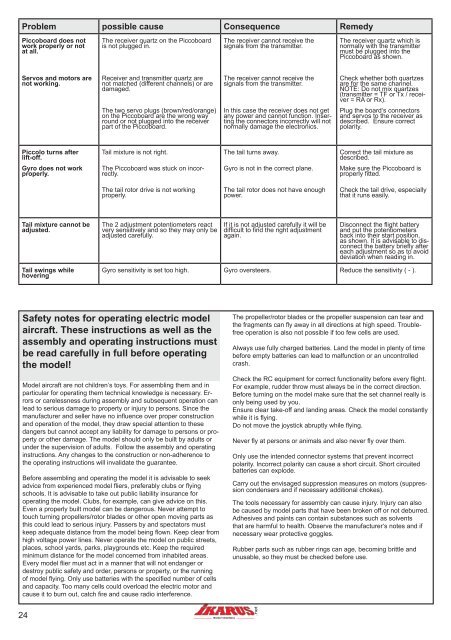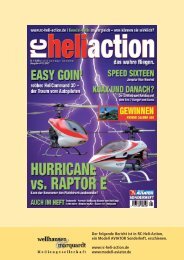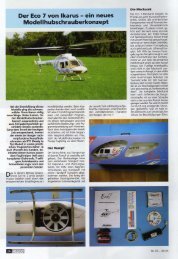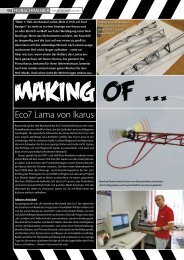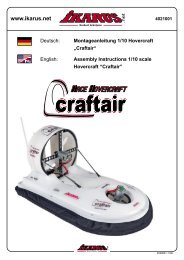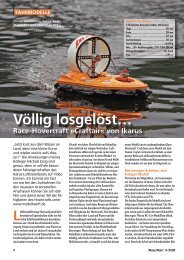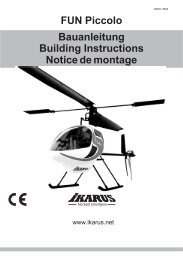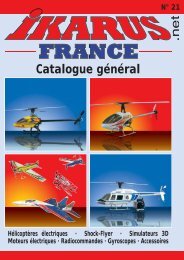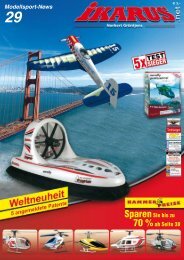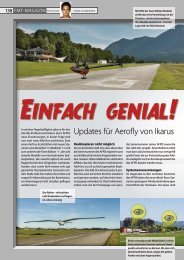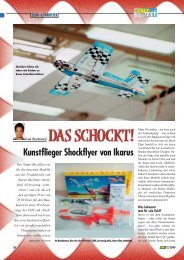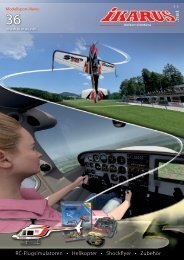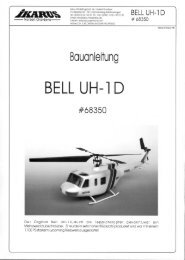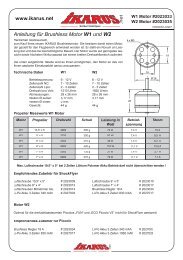Eco Piccolo V2 6049001.indd - Ikarus
Eco Piccolo V2 6049001.indd - Ikarus
Eco Piccolo V2 6049001.indd - Ikarus
Create successful ePaper yourself
Turn your PDF publications into a flip-book with our unique Google optimized e-Paper software.
Problem possible cause Consequence Remedy<br />
Piccoboard does not<br />
work properly or not<br />
at all.<br />
Servos and motors are<br />
not working.<br />
<strong>Piccolo</strong> turns after<br />
lift-off.<br />
Gyro does not work<br />
properly.<br />
Tail mixture cannot be<br />
adjusted.<br />
Tail swings while<br />
hovering<br />
Safety notes for operating electric model<br />
aircraft. These instructions as well as the<br />
assembly and operating instructions must<br />
be read carefully in full before operating<br />
the model!<br />
Model aircraft are not children‘s toys. For assembling them and in<br />
particular for operating them technical knowledge is necessary. Errors<br />
or carelessness during assembly and subsequent operation can<br />
lead to serious damage to property or injury to persons. Since the<br />
manufacturer and seller have no influence over proper construction<br />
and operation of the model, they draw special attention to these<br />
dangers but cannot accept any liability for damage to persons or property<br />
or other damage. The model should only be built by adults or<br />
under the supervision of adults. Follow the assembly and operating<br />
instructions. Any changes to the construction or non-adherence to<br />
the operating instructions will invalidate the guarantee.<br />
Before assembling and operating the model it is advisable to seek<br />
advice from experienced model fliers, preferably clubs or flying<br />
schools. It is advisable to take out public liability insurance for<br />
operating the model. Clubs, for example, can give advice on this.<br />
Even a properly built model can be dangerous. Never attempt to<br />
touch turning propellers/rotor blades or other open moving parts as<br />
this could lead to serious injury. Passers by and spectators must<br />
keep adequate distance from the model being flown. Keep clear from<br />
high voltage power lines. Never operate the model on public streets,<br />
places, school yards, parks, playgrounds etc. Keep the required<br />
minimum distance for the model concerned from inhabited areas.<br />
Every model flier must act in a manner that will not endanger or<br />
destroy public safety and order, persons or property, or the running<br />
of model flying. Only use batteries with the specified number of cells<br />
and capacity. Too many cells could overload the electric motor and<br />
cause it to burn out, catch fire and cause radio interference.<br />
24<br />
The receiver quartz on the Piccoboard<br />
is not plugged in.<br />
Receiver and transmitter quartz are<br />
not matched (different channels) or are<br />
damaged.<br />
The two servo plugs (brown/red/orange)<br />
on the Piccoboard are the wrong way<br />
round or not plugged into the receiver<br />
part of the Piccoboard.<br />
Tail mixture is not right.<br />
The Piccoboard was stuck on incorrectly.<br />
The tail rotor drive is not working<br />
properly.<br />
The 2 adjustment potentiometers react<br />
very sensitively and so they may only be<br />
adjusted carefully.<br />
The receiver cannot receive the<br />
signals from the transmitter.<br />
The receiver cannot receive the<br />
signals from the transmitter.<br />
In this case the receiver does not get<br />
any power and cannot function. Inserting<br />
the connectors incorrectly will not<br />
normally damage the electronics.<br />
The tail turns away.<br />
Gyro is not in the correct plane.<br />
The tail rotor does not have enough<br />
power.<br />
If it is not adjusted carefully it will be<br />
difficult to find the right adjustment<br />
again.<br />
The receiver quartz which is<br />
normally with the transmitter<br />
must be plugged into the<br />
Piccoboard as shown.<br />
Check whether both quartzes<br />
are for the same channel.<br />
NOTE: Do not mix quartzes<br />
(transmitter = TF or Tx / receiver<br />
= RA or Rx).<br />
Plug the board‘s connectors<br />
and servos to the receiver as<br />
described. Ensure correct<br />
polarity.<br />
Correct the tail mixture as<br />
described.<br />
Make sure the Piccoboard is<br />
properly fitted.<br />
Check the tail drive, especially<br />
that it runs easily.<br />
Disconnect the flight battery<br />
and put the potentiometers<br />
back into their start position,<br />
as shown. It is advisable to disconnect<br />
the battery briefly after<br />
each adjustment so as to avoid<br />
deviation when reading in.<br />
Gyro sensitivity is set too high. Gyro oversteers. Reduce the sensitivity ( - ).<br />
The propeller/rotor blades or the propeller suspension can tear and<br />
the fragments can fly away in all directions at high speed. Troublefree<br />
operation is also not possible if too few cells are used.<br />
Always use fully charged batteries. Land the model in plenty of time<br />
before empty batteries can lead to malfunction or an uncontrolled<br />
crash.<br />
Check the RC equipment for correct functionality before every flight.<br />
For example, rudder throw must always be in the correct direction.<br />
Before turning on the model make sure that the set channel really is<br />
only being used by you.<br />
Ensure clear take-off and landing areas. Check the model constantly<br />
while it is flying.<br />
Do not move the joystick abruptly while flying.<br />
Never fly at persons or animals and also never fly over them.<br />
Only use the intended connector systems that prevent incorrect<br />
polarity. Incorrect polarity can cause a short circuit. Short circuited<br />
batteries can explode.<br />
Carry out the envisaged suppression measures on motors (suppression<br />
condensers and if necessary additional chokes).<br />
The tools necessary for assembly can cause injury. Injury can also<br />
be caused by model parts that have been broken off or not deburred.<br />
Adhesives and paints can contain substances such as solvents<br />
that are harmful to health. Observe the manufacturer‘s notes and if<br />
necessary wear protective goggles.<br />
Rubber parts such as rubber rings can age, becoming brittle and<br />
unusable, so they must be checked before use.


